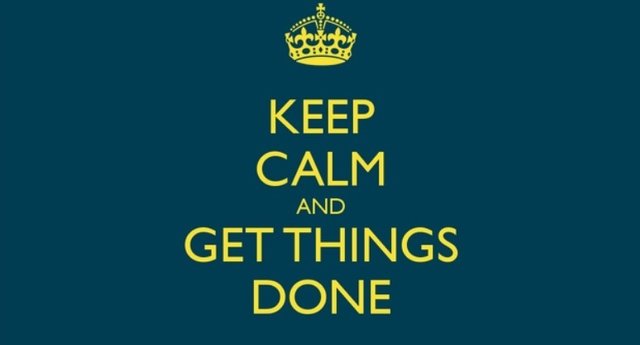If you do not want to be stressed, anxious and puzzled about how to see and decide what is the right thing to do in most of the moments at your work and life, learn the Getting Things Done method!
In part 1 you can read what the GTD methodology is all about, why it helps and there is also a list of all 5 steps of GTD.

Source
Let's dig a bit more in each of the 5 steps of GTD that will help you bring more calm control in any life or work situation:
Step one: CAPTURE
In the CAPTURE step, we write down or physically collect - capture everything that catches our attention (all that we want or need to do and all that is not (yet) such as we want or not where we want to have it). Collect step is performed by using the capturing tools (which can be as simple as paper and pencil, or as complex as a digital application).
Advice from my experience: Please make sure that you capture and collect ALL that "puzzles" you. This is not a "to do" list - you are just collecting "open loops" in your physical, digital and mental world.

Photo by BRUNO CERVERA on Unsplash
Step two: CLARIFY
Then all collected items have to be clarified… so the step is called CLARIFY. In this step, we decide about all collected items what is it's desired outcome and fist next step that will bring us closer to achieving the desired result.
Advice from my experience: In practice you will do steps 2 and 3 almost simultaneously... once you know the desired outcome and first next action, you go to step three.
Step three: ORGANIZE
Results of the clarification (the first next step and the desired outcome) have to be parked at the appropriate places (different lists, calendar) of your reliable GTD system. This step of GTD is called ORGANIZE. We organize reminders and information in appropriate clear categories and we make sure that set of lists and platform is individualized to our personal preferences and needs. You can use digital applications or paper solution or combination. This part will require some initial effort (to set up the lists that will best cover your needs and preferences). I believe that Evernote is a fine solution and you can start to learn how to use it here.
Advice from my experience: In addition to calendar and some kind of to-do list you should add at least list of all your projects (just titles of multi-step desired outcomes), "waiting for" list, which consists of all actions that others are currently doing "for you" and "someday-maybe" and "agendas for people and meeting". You will also benefit if your current "to-do" list is a bit diversified based on the context where the next action should happen and next actions should be written in a way, that you easily grasp even after few days or weeks what, where and with whom you intend to do.
Please watch this short 3 minutes demonstration with David Allen and you will see and better understand what exactly we do in 2nd and 3rd step:
Step four: REFLECT AND REVIEW
When we actually work, we just take a look at the relevant list (list for the context in which we currently are… like "in the office", "at home" ... So we daily REVIEW the calendar and next action lists and decide what the next activity is most meaningful at a given moment. Additional insight into all our work is done by so-called. WEEKLY REVIEW takes about an hour per week and is dedicated to reviewing the full picture of our commitments and obligations. We also decide on the next steps and possible changes.
Advice from my experience: If you take only one item from the whole blog that you will implement, do go for the weekly review and see from higher perspective whether your work in life is going in the desired direction!"
The fifth step - ENGAGE – is easy if first four steps were done. You just engage in the most meaningful item from your lists considering the context you are in, the available amount of time, the energy you are equipped with and priority of the next task you will work on. And what is best, you can then really focus on this task, as you know that you are working on the most meaningful item at this particular moment. At first glance, it looks like the GTD method only means a lot of extra work. Every time the workshop participants in the first responses to the method comment: "In all the tasks that I have to do, now I will have to make four additional steps beforehand!" Or: "I know, however, that I have to do all this, why would you give it-and still to the lists? " I admit: I also had similar concerns at the very first reading of the book. I had to test the method in practice to be able to say that the method adds value and enables me to be calm and present. The method does not mean unnecessary extra work, but it helps us to establish the conditions that we work more calmly, focused and flexible: About listed and other direct and indirect benefits I will write in part 3. Important info: Source of the majority of information in this blog is from the book Getting Things Done by David Allen. I've added some personal experiences as a user and practitioner of GTD and also as a registered Master Trainer of GTD Methodology. In few words... My main topic here is running. I also post about origami and GTD(Getting Things Done) and from time to time about other topics that I find interesting, intriguing or fun. You might get a better picture of who I am and what I do and aspire for if you read some of my other posts: So to be short and sweet, my introduction in #-form would look like this:
Photo by Aaron Burden on Unsplash
Step five: ENGAGE
Advice from my experience: Idea of GTD is that you put more work into first 4 steps than you are used to, but if you do... the 5th step - is so much easier!
Source
Hm... looks like a lot of extra work... or is it just a good investment that more than pays off?

I joined Steemit in December 2017. @blockchain48 introduced me to it and explained to me how it works and why I could enjoy it. And I do enjoy it! I like the diversity and spirit of Steemit!
- You can read part 1 of this blog here.
- There was one other post about reducing of your stuff and minimalistic approach with help of GTD: Are you moving to new home or do you have too much stuff? Optimize and minimize!.
- My core daily habit is running. If you do not run yet and would like to try it... I've written a blog: Manual for wannabe runners, where you can find tips and tricks, how to start running.
- As a Streak Runner, I wanted to share more information about this specific running approach. You can read more about Streak Running in my blog All you wanted to know about Running Streak - part 1, part 2 and part 3.
- I am revealing about my first steps in running arena in this post: How I started to run or can a workaholic and sedentary couch potato become a marathon runner?.
- I love origami and here is my post about the art of folding papers or what anybody should know about it.
- This was my introduction post on Steemit: 2018 is here! Any New Year's resolutions? And who am I to write about this?.
#streakrunningday672 #runner #mother #girlfriend #friend #daughter #sister #vegan #steemian #origamicreator #origami #gtdmastertrainer #gtd #gettingdailyrunsdone #bizinsakiden #findyourstrong #runningproject #runforsteem #vsakodnevnitek #runeveryday #runstreak #streakrunner #veganrunners #runningonplants #plantpowered #plantstrong #veganstrong #compassionarhlete #minimalism #catlover #sealover #coffeelover #sincereconversationfan